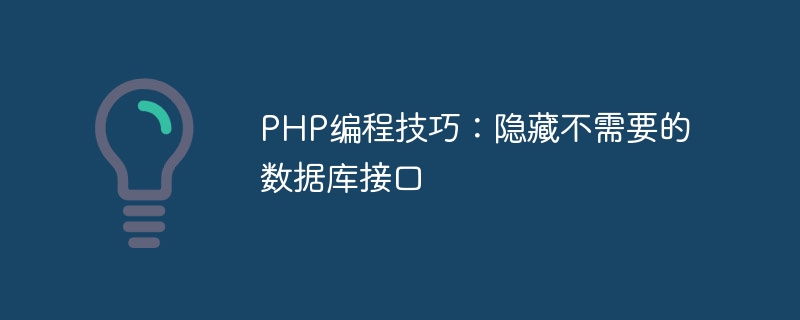Home >Backend Development >PHP Tutorial >PHP Programming Tips: Hide Unnecessary Database Interfaces
PHP Programming Tips: Hide Unnecessary Database Interfaces
- PHPzOriginal
- 2024-03-09 22:12:03877browse

Summary: In PHP programming, sometimes we need to hide some database interfaces that do not need to be accessed by the outside to ensure the security and stability of the application. This article will introduce some PHP programming techniques, teach you how to hide unnecessary database interfaces, and provide specific code examples.
In modern web application development, the database is a vital part. PHP is a popular server-side scripting language that is often used to interact with databases. However, sometimes we do not want all database interfaces to be exposed to the outside world, perhaps for security reasons or for structural clarity. Next, we will introduce several methods to hide these unnecessary database interfaces.
Method 1: Use namespaces
In PHP, you can use namespaces to organize related functions, classes, interfaces, etc. together. By placing database interfaces under specific namespaces, you can avoid direct access to these interfaces from other parts. The following is an example:
namespace Database;
class DatabaseConnection {
// 数据库连接相关的代码
}
class DatabaseQuery {
// 数据库查询相关的代码
}When referencing the namespace in other parts, you only need to use the use keyword:
use DatabaseDatabaseConnection;
Method 2: Use access control modification Character
In PHP, we can use access control modifiers to restrict access to members of a class. Access control to these members can be achieved by adding modifiers such as public, protected, or private before the member variables or methods of the class. Here is an example:
class Database {
private $connection;
private function connect() {
// 连接数据库的代码
}
}In the above example, the $connection variable and connect() method are defined as private and cannot be directly accessed from the outside, thus hiding database connection details.
Method 3: Use singleton mode
The singleton mode is a design pattern that ensures that a class has only one instance and provides a global access point. By encapsulating database-related code in a singleton class, you can hide these details and implement lazy loading when needed. The following is a simple example of singleton mode:
class Database {
private static $instance;
private function __construct() {
// 初始化数据库连接
}
public static function getInstance() {
if (!isset(self::$instance)) {
self::$instance = new Database();
}
return self::$instance;
}
}By calling the Database::getInstance() method, you can obtain a singleton instance and access the database interface.
Method 4: Use interface inheritance
By using interface inheritance, you can define database-related interfaces in a separate interface and implement these interfaces in the required classes. In this way, the outside world can only access the interface definition, but cannot directly access the specific implementation details. The following is an example:
interface DatabaseInterface {
public function connect();
public function query($sql);
}
class MySQLDatabase implements DatabaseInterface {
public function connect() {
// 连接MySQL数据库
}
public function query($sql) {
// 查询数据库
}
}In the above example, the outside world can only access database-related methods through the DatabaseInterface interface, but cannot directly access the details of the MySQLDatabase class. .
Conclusion
Through the above methods, we can effectively hide unnecessary database interfaces and ensure the security and stability of the application. In actual development, you can choose the appropriate method to hide the database interface according to specific needs. I hope this article is helpful to you and can improve your technical level in PHP programming.
The above is the detailed content of PHP Programming Tips: Hide Unnecessary Database Interfaces. For more information, please follow other related articles on the PHP Chinese website!

